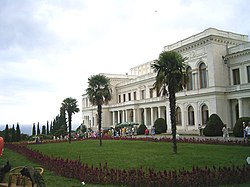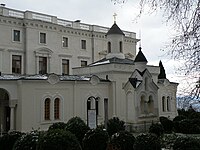Livadia Palace: Difference between revisions
1,717,507 edits No edit summary |
Rescuing 1 sources and tagging 0 as dead. #IABot (v1.6.1) |
||
| Line 18: | Line 18: | ||
The palace was once used as a mental institution, and is now a historical museum. Most of the historical furnishings have been lost, but anything that has been recovered can be seen for a small fee. In August 2007 the palace was recognized as a ''landmark of modern history'' by the [[Seven Wonders of Ukraine]] project. Ukrainian pop singer [[Sofia Rotaru]], who celebrated her 60th birthday at the palace in the company of the presidents of Russia, Ukraine, and Moldavia – the second such meeting since the [[Yalta Conference]] – funded the restoration of Livadia Palace in 2008.<ref>{{cite web|url=http://www.tden.ru/articles/024175/|title=Sofia Rotaru decided to take Livadia Palace in charge. | work= Твой День | accessdate=2007-12-28}}</ref> |
The palace was once used as a mental institution, and is now a historical museum. Most of the historical furnishings have been lost, but anything that has been recovered can be seen for a small fee. In August 2007 the palace was recognized as a ''landmark of modern history'' by the [[Seven Wonders of Ukraine]] project. Ukrainian pop singer [[Sofia Rotaru]], who celebrated her 60th birthday at the palace in the company of the presidents of Russia, Ukraine, and Moldavia – the second such meeting since the [[Yalta Conference]] – funded the restoration of Livadia Palace in 2008.<ref>{{cite web|url=http://www.tden.ru/articles/024175/|title=Sofia Rotaru decided to take Livadia Palace in charge. | work= Твой День | accessdate=2007-12-28}}</ref> |
||
Numerous academic conferences have been held at the palace. [http://www.livadia-palace.crimea.com/publishing.htm Palace staff actively publish their research.] Visitors are particularly interested in the [http://krim-konference.at.ua/index/conference_yalta_45_13/0-5 events of 1945.] |
Numerous academic conferences have been held at the palace. [https://web.archive.org/web/20130522133112/http://www.livadia-palace.crimea.com/publishing.htm Palace staff actively publish their research.] Visitors are particularly interested in the [http://krim-konference.at.ua/index/conference_yalta_45_13/0-5 events of 1945.] |
||
==Architecture== |
==Architecture== |
||
Revision as of 03:19, 4 January 2018



Livadia Palace (
History


Formerly granted to
Around 1909, Nikolay Krasnov, Yalta's most fashionable architect, responsible for the grand ducal residences in Koreiz, was engaged to prepare plans for a new imperial palace. The Tsar's diary indicates that the design was much discussed in the Imperial Family; it was decided that all four façades of the palace should look different. After 17 months of construction, the new palace was inaugurated on 11 September 1911. In November Grand Duchess Olga Nikolaevna celebrated her 16th birthday at Livadia.
After the February Revolution in 1917, Nicholas's mother, Dowager Empress Maria Feodorovna, fled to Livadia with some other members of the Imperial family. They were eventually rescued by the British ship HMS Marlborough, sent by the Dowager Empress's nephew, King George V.
During the
The palace was once used as a mental institution, and is now a historical museum. Most of the historical furnishings have been lost, but anything that has been recovered can be seen for a small fee. In August 2007 the palace was recognized as a landmark of modern history by the Seven Wonders of Ukraine project. Ukrainian pop singer Sofia Rotaru, who celebrated her 60th birthday at the palace in the company of the presidents of Russia, Ukraine, and Moldavia – the second such meeting since the Yalta Conference – funded the restoration of Livadia Palace in 2008.[2]
Numerous academic conferences have been held at the palace. Palace staff actively publish their research. Visitors are particularly interested in the events of 1945.
Architecture

The Livadia Palace is built of white Crimean
The palace contains 116 rooms, with interiors furnished in different styles. There are a
See also
- Tsar's Path, passes above the palace complex
- Dulber, nearby palace designed by the same architect
- Yusupov Palace, another nearby palace
- Vorontsov Palace, in neighboring Alupka
References
- Verlorene Siege. 2000. 16 Auflage. Bonn. p.283-285
- ^ "Sofia Rotaru decided to take Livadia Palace in charge". Твой День. Retrieved 2007-12-28.

